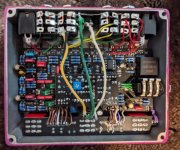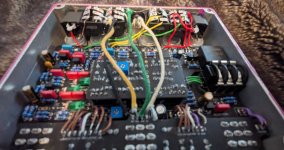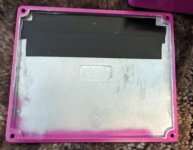puntygr4p3s
New member
Hi all,
I recently finished a build of Aion FX's Xenotron clone of the Lovetone Flange With No Name. As far as I can tell, the effect seems to be working, good range of sounds out of both the space (tremolo) and time (modulation) circuits. However there seem to be some weird things happening with signal loss depending on the settings of the ring lift and stereo/mono switches. All of the below pertain to using the pedal with only the space/mono output:
Ring lift switch up | stereo/mono switch in any position: Good, strong signal in bypass and with tremolo from the Space circuit. As per design, modulation from the Time circuit is not present in the mono output in this setting.
Ring lift switch down | stereo/mono switch in stereo position: Slightly weaker bypass signal, but pretty good. When only Space is engaged, signal strength is good but modulation is very weak. When Time and Space are engaged, Time signal is good but if "action" is turned towards the center (reducing mix level of the Time circuit), Space signal is very weak.
Ring lift switch down | stereo/mono switch in mono position: Much weaker bypass signal with a lot of missing high and mid frequencies. When only Space is engaged, modulation has decent strength but the overall signal level is much lower than when the ring lift switch is engaged, missing highs and mids. When both Time and Space are engaged, high frequencies come back, but again there seems to be relatively weak modulation from the Space signal as the Time mix is turned down.
I double checked the wiring and checked continuity between the solder pads on all the input/output jacks and haven't found any obvious problems. Wondering if anyone else has had similar issues with this build or has ideas on where to focus troubleshooting. Thanks for having a look! Sorry for the rough picture quality...
The Space/mono out and the Time out jacks are the rightmost in these pictures



Note I have electrical tape on the bottom plate to ensure nothing shorts out against it, since the build was cramped and soldering tabs on the jacks stuck out past the bottom of the enclosure before being bent inwards.

I recently finished a build of Aion FX's Xenotron clone of the Lovetone Flange With No Name. As far as I can tell, the effect seems to be working, good range of sounds out of both the space (tremolo) and time (modulation) circuits. However there seem to be some weird things happening with signal loss depending on the settings of the ring lift and stereo/mono switches. All of the below pertain to using the pedal with only the space/mono output:
Ring lift switch up | stereo/mono switch in any position: Good, strong signal in bypass and with tremolo from the Space circuit. As per design, modulation from the Time circuit is not present in the mono output in this setting.
Ring lift switch down | stereo/mono switch in stereo position: Slightly weaker bypass signal, but pretty good. When only Space is engaged, signal strength is good but modulation is very weak. When Time and Space are engaged, Time signal is good but if "action" is turned towards the center (reducing mix level of the Time circuit), Space signal is very weak.
Ring lift switch down | stereo/mono switch in mono position: Much weaker bypass signal with a lot of missing high and mid frequencies. When only Space is engaged, modulation has decent strength but the overall signal level is much lower than when the ring lift switch is engaged, missing highs and mids. When both Time and Space are engaged, high frequencies come back, but again there seems to be relatively weak modulation from the Space signal as the Time mix is turned down.
I double checked the wiring and checked continuity between the solder pads on all the input/output jacks and haven't found any obvious problems. Wondering if anyone else has had similar issues with this build or has ideas on where to focus troubleshooting. Thanks for having a look! Sorry for the rough picture quality...
The Space/mono out and the Time out jacks are the rightmost in these pictures



Note I have electrical tape on the bottom plate to ensure nothing shorts out against it, since the build was cramped and soldering tabs on the jacks stuck out past the bottom of the enclosure before being bent inwards.




